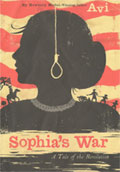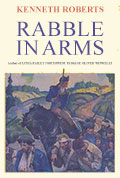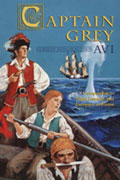 The most common question asked of authors is, “Where do you get your ideas?” Consider my newest book, Sophia’s War, a tale set in New York City (NYC) during the American Revolution.
The most common question asked of authors is, “Where do you get your ideas?” Consider my newest book, Sophia’s War, a tale set in New York City (NYC) during the American Revolution.
I was born and raised in Brooklyn (NYC), close to the site of the biggest battle fought during the American Revolution, the Battle of Brooklyn.
In 1947, when I was nine, The American Past, an illustrated history of the United States, came into my home. The first of its kind, its pictures fascinated me. I went through it countless times, gained a basic outline of US history, and a life-long love of history. I still have that book. I still read history.

From 1947 to 1950 I was an avid listener of the CBS radio series, You Are There, which reported great moments in history as if they were just happening.
Not far from my home was the place where the notorious British prison ships lay at anchor. At some point—I don’t know when—I learned of what happened.
 As a teenager I read Kenneth Roberts’ Rabble in Arms. Roberts was the foremost historical fiction writer of his time, and my introduction to historical fiction. This book focused on General Benedict Arnold. The book gave me my first real introduction to Arnold, his fascinating history, his tragic downfall.
As a teenager I read Kenneth Roberts’ Rabble in Arms. Roberts was the foremost historical fiction writer of his time, and my introduction to historical fiction. This book focused on General Benedict Arnold. The book gave me my first real introduction to Arnold, his fascinating history, his tragic downfall.
In high school I began to buy (and read) books offered by the History Book Club. Some still sit on my shelves.
In college I majored in history, mostly American and British history.
 My first historical work was Captain Grey, (1977) a novel about the bitter aftermath of the American revolution. I would write some 35 other works of historical fiction.
My first historical work was Captain Grey, (1977) a novel about the bitter aftermath of the American revolution. I would write some 35 other works of historical fiction.
In 1976 I watched battlefield enactments of the Revolution. Those experiences led me (1984) to write The Fighting Ground, about a boy fighting in the American Revolution. It’s one of my most successful books, and the first historical fiction for which I did serious research.
 In 2007, I published Iron Thunder, a Civil War novel about the Monitor and Merrimack. I wanted to write an historically accurate account of that battle, while inserting a fictional character, and thereby creating an exciting adventure (and historical knowledge) for my readers. That was followed by Hard Gold—same format—about the Colorado gold rush. Before I had finished it, I conceived a similarly constructed story about the American Revolution. I decided it would begin with an account of Nathan Hale’s death. Three years before I started to write the book I knew the first line: “It is a terrible thing to see a man hang.”
In 2007, I published Iron Thunder, a Civil War novel about the Monitor and Merrimack. I wanted to write an historically accurate account of that battle, while inserting a fictional character, and thereby creating an exciting adventure (and historical knowledge) for my readers. That was followed by Hard Gold—same format—about the Colorado gold rush. Before I had finished it, I conceived a similarly constructed story about the American Revolution. I decided it would begin with an account of Nathan Hale’s death. Three years before I started to write the book I knew the first line: “It is a terrible thing to see a man hang.”
Where did I get the ideas for Sophia’s War? Throughout my life.